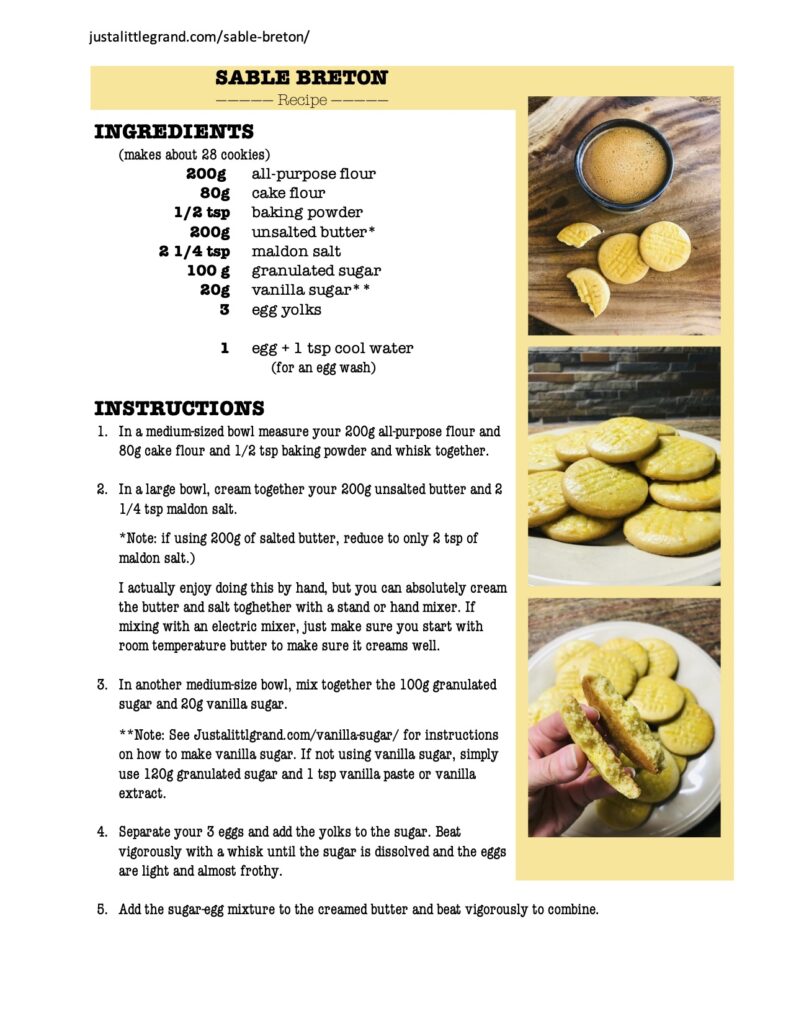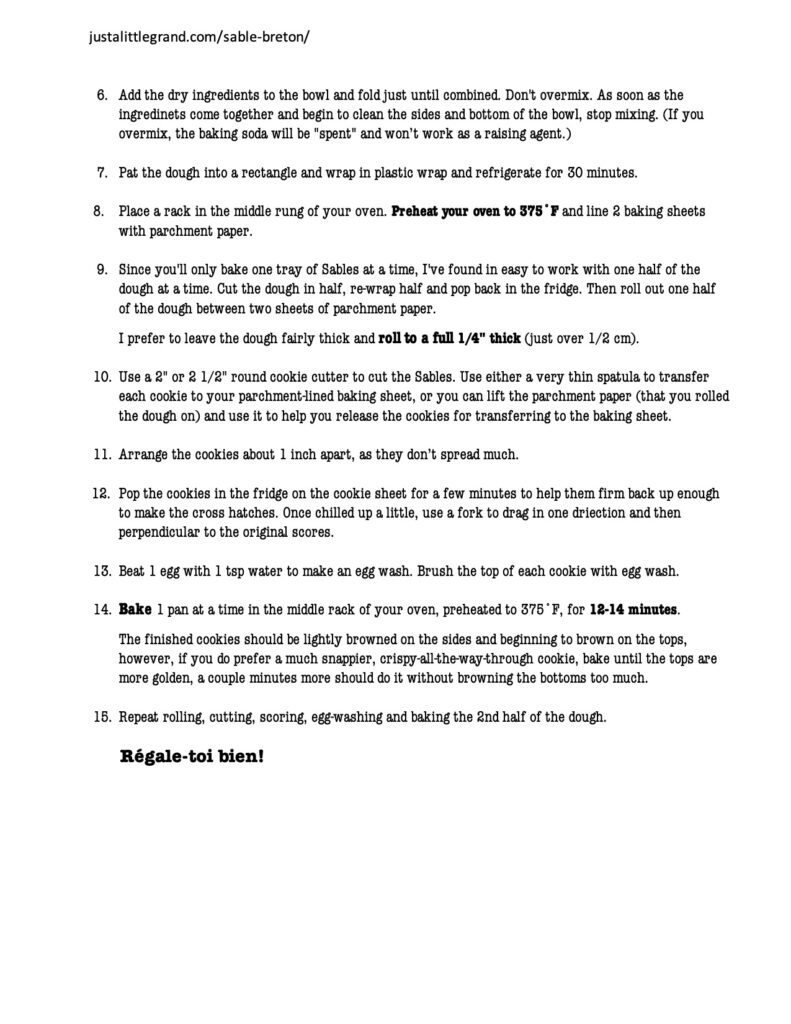Sable Breton
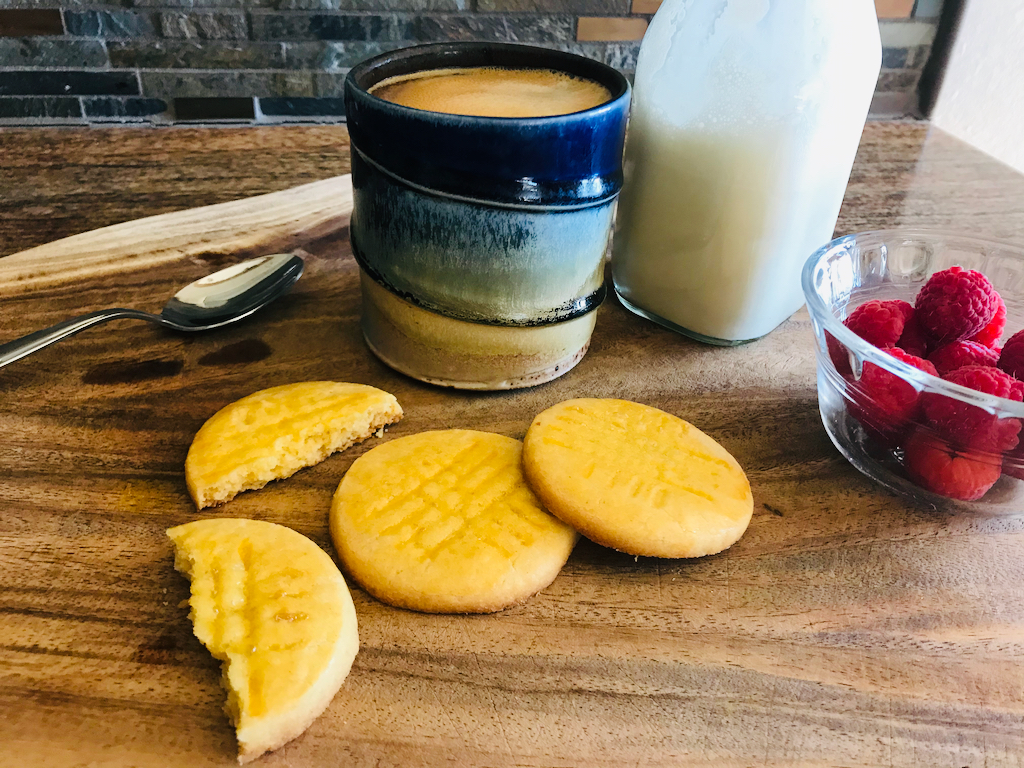
French Butter Cookies
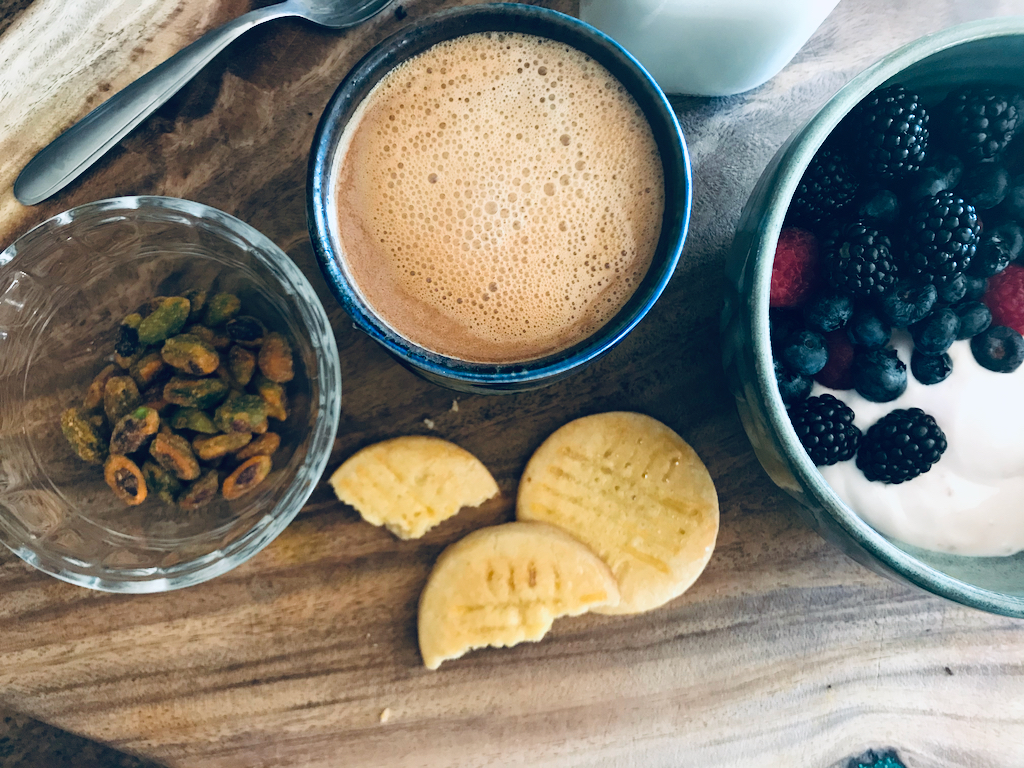
(Jump to the recipe file here.)
I believe the first time I ever tried these delightful French butter cookies was from a gift basket at Christmas time from ABS, a small payroll company that does payroll for my husband’s crew of all of 6 people 4 or 5 times a year. Little did the folks at ABS know that it would send me on a three-year search for a home-made recreation of these cookies with their lightly crumbly texture.
That’s what the name actually means, Sable is for their sandy texture.
They’re not quite shortbread, not strictly a butter cookie, they’re somewhere in between.
As a matter of fact, the first recipe that I found that was close, was from Mon Petit Four, but for me, it was just a smidge too much on the shortbread side.
{The following is a long digression and warning about one road not to go down, regarding chemical leavening and baking:
The next recipe I found that I wanted to try was from David Lebovitz, but those did not work for me at all. Allow me to explain why, because it wasn’t all his recipe’s fault. But here’s what went wrong in those Sables Bretons for me: They nearly doubled in size on me, which I didn’t expect (even though they’re loaded with baking powder, it shouldn’t have surprised me so much, but it did), and then they fell and flattened after cooling. They had an off smell while baking, and unfortunately, tasted like they smelled. I am only diverting and explaining all of this just to help save you the same experimentation. – David Lebovitz’s recipes are usually perfect and pure delight, and that’s why I tend to follow every one of his directions to a T. I got his ice cream book for Christmas, The Perfect Scoop, and am unbelievably excited to try out every recipe this summer. In his Sables Bretons recipe though, he calls for 4 tsp of baking powder, and since these tender buttery cookies call for so much (I’ve never once used so much baking powder in any one recipe), he specifically says to use an aluminum-free baking powder, which of course I didn’t have on hand. Mine is the Clabber Girl brand, in which the third ingredient is Sodium Aluminum Sulfate. So I looked into baking powder substitutes and found this solution of combining ½ tsp cream of tartar with ¼ tsp of baking soda to equate 1 tsp of baking powder. Since my baking soda is aluminum free, I thought this would do the trick. I was wrong. Though cream of tartar in no way contains aluminum, because it’s an acid, when you use all of 2 tsp in a cookie as light and delicate tasting as Sables Bretons, it just does not work. The acid overpowers the butter and sugar. It tasted like a science experiment, and our elementary school’s science fair was last week, so I didn’t need this science experiment right now. I didn’t feel like I wanted to try D. Lebovitz’s exact recipe again, simply because I was still put off by the amount of baking powder, aluminum free or no, that it calls for. It’s a lot. (And he even states that he has cut down the amount from the original recipe that he adapted!)}
So I tinkered a little more, but this time with total success!
I made a hybrid of the good parts of both recipes and glanced at the ingredient lists of the other 2 or 3 recipes I could find, and came up with these crumbly, tender, light, sandy-in-a-good-way Sable Breton.


Sable Breton

You’ll Need:
- 200g all-purpose flour
- 80g cake flour
- ½ tsp baking powder
- 200g unsalted butter*
- 2 ¼ tsp Maldon salt**
- 100g granulated sugar
- 20g vanilla spice sugar***
- 3 egg yolks
- 1 egg + 1 tsp cool water (for an egg wash)
In a medium-sized bowl measure your 200g all-purpose flour, 80g cake flour and ½ tsp baking powder and whisk together. (I included a little smidge of cake flour for the tenderness that the lesser-protein flour lends.)


In a large bowl, the one you’ll do all the final mixing in, measure out your 200g unsalted butter and 2 ¼ tsp flaky Maldon salt. **If using salted butter simply reduce the amount of Maldon salt to 2 tsp.




*I like to smash the butter and salt together and then just cream it with my hands at first and then switch to a whisk, but feel free to be a normal, modern-day human being and use a mixer, just bring your butter to room temperature before creaming it with the salt.
In another medium-sized bowl, measure in your 100g granulated sugar and 20g vanilla spice sugar and whisk together to combine. (***If you don’t want to make vanilla spice sugar, no worries – I already had some on hand for making Palmiers – just use 120g granulated sugar and 1 tsp of vanilla paste or vanilla extract.)


Separate your eggs and beat your 3 egg yolks into your sugar until very light and creamy.





Add the sugar-egg to your butter-salt and beat together vigorously until that mixture is also light and fluffy.


Add your dry ingredients to the bowl and fold together just until combined and just until the mixture starts to clean the sides and bottom of the bowl. Don’t overmix too much. (If you overmix too much, your baking soda will be “spent” and won’t work as a raising agent, and you won’t get that perfect, sandy, light texture that completes the taste of these cookies.)




Once your dough is just mixed, pat it together into a rectangle, wrap in plastic wrap and refrigerate for 30 minutes.


After 30 minutes, place a rack in the center rung of your oven, preheat your oven to 375˚F, and line two baking sheets with parchment paper.
You’ll only bake 1 tray of cookies at a time, so divide your dough in half and work with only half at a time. (Re-wrap the first half and just pop it back into the fridge until its turn.)


The dough will take a minute or two to become roll-able, and it will still be a bit hard to roll, but you want it nice and chilled and firm.
Roll your dough between two sheets or parchment to make it much easier (than flouring a counter and rolling pin). (This also makes rolling Linzer cookie dough much easier too, fyi.)
Make a few indentations in your dough to give the rolling pin some leverage, and if you stop the rolling pin before it goes past the edge of the dough, it also keeps the thickness more even. Rotate the dough as needed and roll, almost to the edges.


Roll the dough to ¼” thick (just over ½ cm). Use a 2” or 2 ½” round cookie cutter to cut.



Use either a thin spatula to help you transfer each cookie to the baking sheet, or you can go underneath the parchment paper and use it to help you lift the cookies up.

Place cookies about 1 inch apart, as they don’t spread much.

Pat any scraps back together and re-roll to ¼” thick.


Once your cookie sheet if filled, place the entire sheet in the refrigerator for a few minutes to firm the cookies back up enough to score the tops.

Once firmed up, drag a fork slowly across each cookie top, using one hand to steady the cookie so it doesn’t slide. Then score in a perpendicular direction.


(Funny side story: I found a Martha Stewart recipe where it looks as though she uses a leather tooling stamp to basket weave the tops of her cookies… Do you think Kevin would mind if I borrowed his basket weave stamp to tool some Sables Bretons? It actually turned out to be a recipe for Browned-Butter Honey Cookies that she basket stamped, so maybe I’ll wait until I make some of those to borrow a leather stamping tool.)
Beat 1 egg with 1 tsp cool water and brush the top of each cookie with egg wash.



Bake 1 tray at a time in the middle rack of your 375˚F oven for 12 – 14 minutes.

I like my Sables Bretons to be lightly browned on the sides and that browning to be just creeping onto the tops, because this means the centers are ever-so-slightly soft with a moist crumb and crumble. If you prefer your Sables Bretons to be snappier and crispier all the way through, bake a couple minutes more until the cookies have become golden all across the tops. (You may need to watch the bottoms for those last couple minutes and pull them before the bottoms brown too much.)



You can allow the cookies to cool right on the baking sheet.
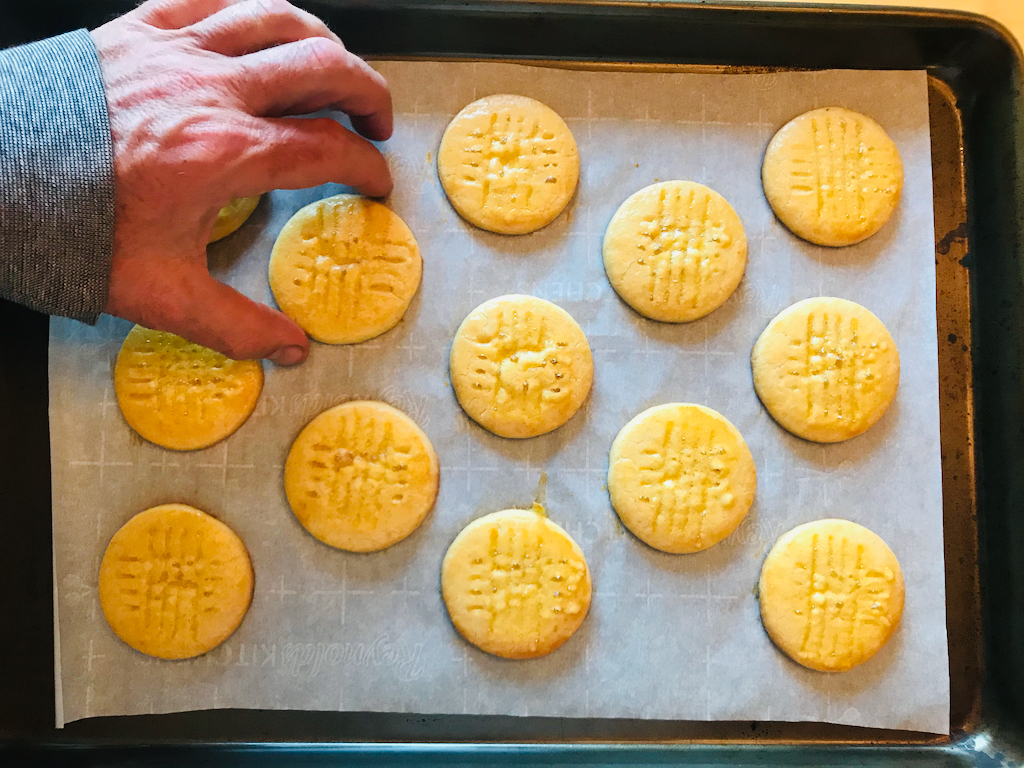
If you’ve let your cookies brown those extra couple minutes of baking, you may want to remove them to a cooling rack to cool completely (after cooling a couple minutes in the pan.)
Repeat rolling, cutting, placing, chilling, scoring, egg washing, and baking with the second half of the dough.
Régale-toi bien! (While they last…)
—Becky


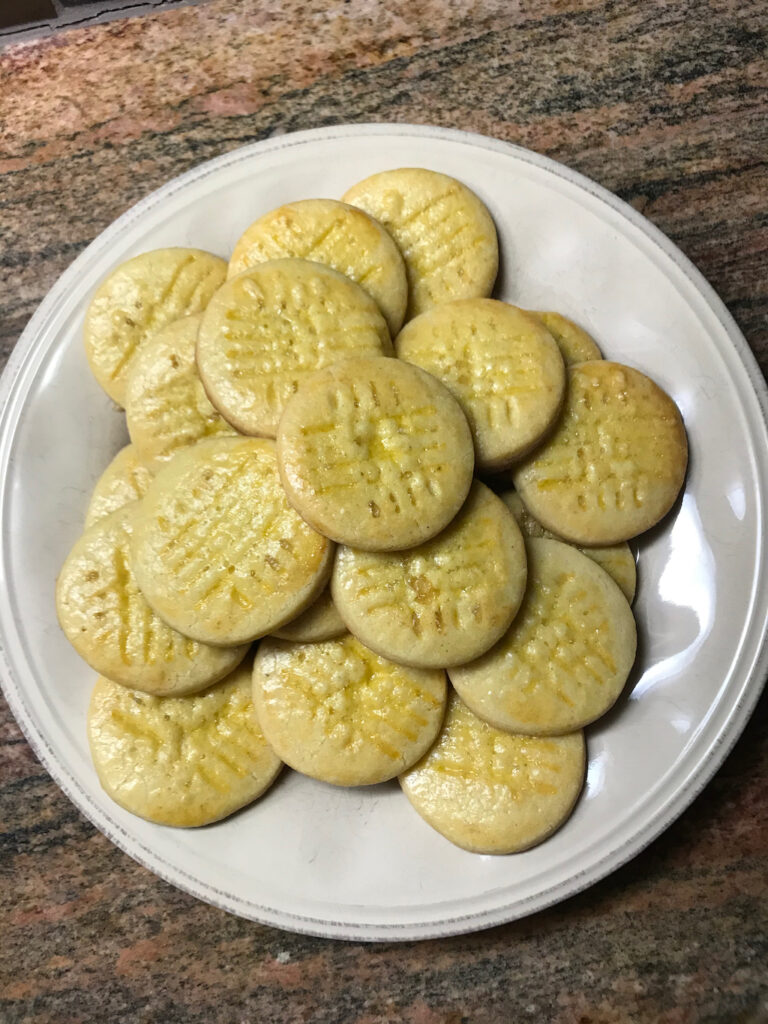
Download the recipe file here.
